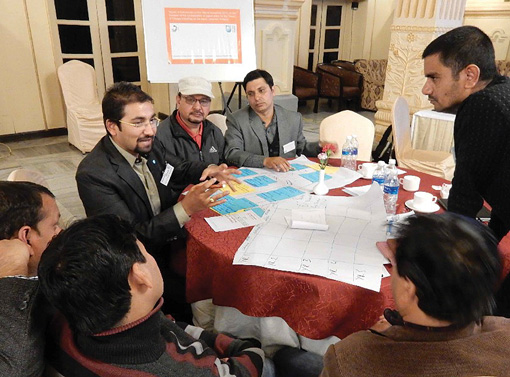3.1 Working with stakeholders
It is not a straightforward process to identify stakeholders, let alone gather so many together. Usually you will have to make compromises. It is important to consult your key partners, such as the district health officers in this case, to help identify and invite your other potential stakeholders. You need also to consider the total number of participants. Aim for no more than about 20. With more than this it becomes difficult to ensure effective participation.
It is important to do some thorough research prior to gathering your stakeholders. Presenting the information that is available on the identified problem will help to set the scene (e.g. a map of healthcare facilities, data on the distribution of health workers, and details of other interventions that are currently taking place or planned). A summary of evidence in favour of possible interventions (steps needed to bring about change) can also be useful as you move through the model.
When you hold your workshop, you can discuss the problem with stakeholders and see if there is broad agreement about the way the problem has been identified. You may find it useful to review the Causes Diagram which can be found on page 43 of the DIY Toolkit [Tip: hold Ctrl and click a link to open it in a new tab. (Hide tip)] . This can help to build a shared understanding about the problem, its effects and possible solutions. From there, you could break into small groups and ask each group to complete the section in the Theory of Change on identifying the key audience. You could then ask a representative from each small group to present back to the whole group and discuss any variations that have arisen.
The next step would be to try to narrow down the options and seek agreement, perhaps using a democratic process, voting from a choice of options (Figure 2). You could have a master version of the template on the wall that you complete as you gain consensus, then moving on to the next section to repeat the process. What arises in later sections may cause you to challenge what has been discussed in previous sections, so the process is likely to be iterative.

Activity 5
Imagine that you are going to facilitate a Theory of Change workshop. You have about 20 stakeholders coming to your workshop. Develop an outline agenda for the day and type it in the box below.
Discussion
It’s a good idea to start the day by explaining the model of the Theory of Change to your group, perhaps using an example, and then use small-group work (Figure 2) to complete the model for your project stage by stage, reverting to whole-group discussions to talk through areas of contention and to challenge assumptions.
Don’t forget to build in tea and lunch breaks to keep energy levels high. You can also consider using energisers – short physical activities – to keep people active, and build in competitions, perhaps for the clearest, best-worded statements that others vote on. You can give out prizes – tasty treats, perhaps?
3 The participatory process of identifying the Theory of Change for a programme or idea
